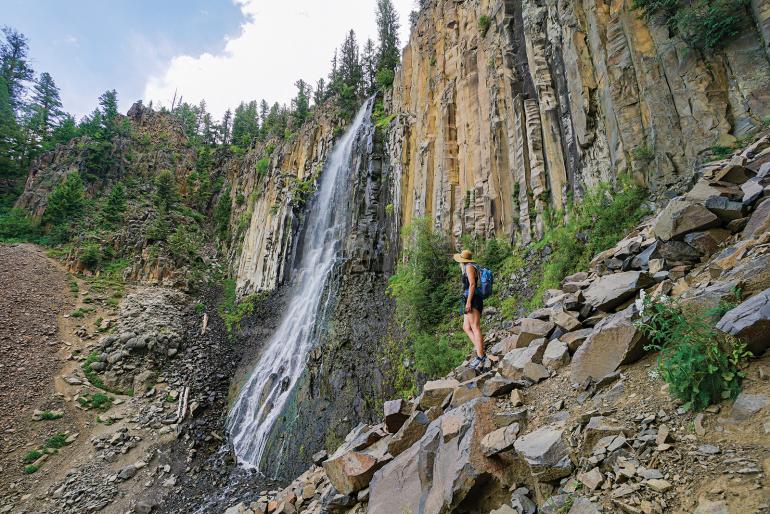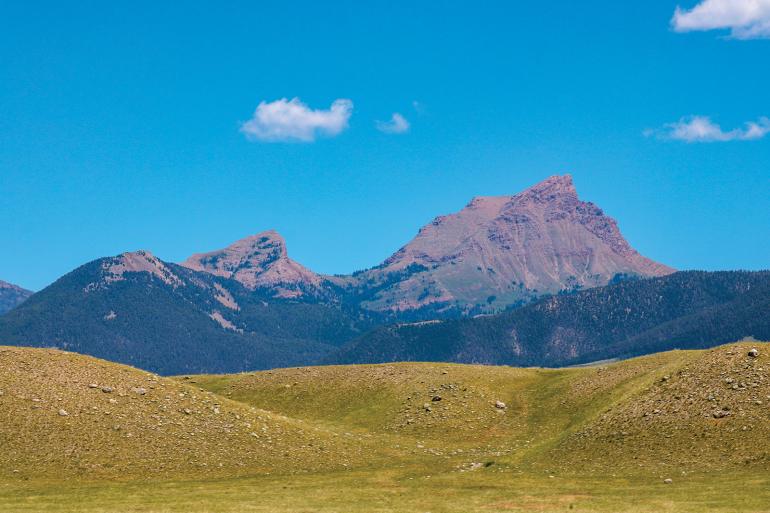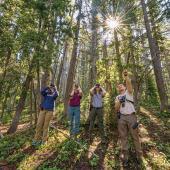Rock & Roll
A field guide to southwest Montana’s signature stones.
Sitting at the confluence between the central and northern Rockies, Bozeman has a varied, complex geological history—which means you’ll find lots of different types of rocks in our mountains. You’ve probably heard a few of the common names thrown around, but how can you tell what you’re looking at out in the field? Here’s a rundown on some of the most distinctive rocks in southwest Montana.
Limestone
Often appearing as steep white cliffs in the foothills of our mountains, limestone is one of the most common types of rock in Montana. It’s a sedimentary rock formed from the remnants of ancient coral reefs, which is why it’s often loaded with fossils. Limestone is more resistant to weathering and erosion than other sedimentary rocks such as sandstone and shale, so it remains intact in continuous cliff bands across the mountains. Prime examples of local limestone outcrops are Storm Castle, Bozeman Pass, and the crest of the Bridger Ridge.
Sandstone
Though less noticeable than limestone, sandstone is just as abundant in southwest Montana. Sandstone is porous and absorbs water, which causes it to weather much faster than limestone; hence it doesn’t often form sheer cliffs. Whereas limestone is formed in reefs, sandstone is formed along the shorefront where seawater is eroding away at the land. Fluctuating sea level over millions of years causes alternating bands of sandstone and limestone, as beaches and reefs are deposited on top of one another. You can find sandstone in Bear Canyon, and in the Bridgers between bands of limestone. A sandstone conglomerate also forms the dramatic crown of the Sphinx.
Gneiss
Pronounced “nice,” this metamorphic rock offers geologists plenty of material for making puns. It’s also referred to as “basement rock,” as there’s a gneiss foundation beneath nearly the entire continent of North America—and all of the other continents, for that matter. It’s the oldest type of rock on Earth, with typical specimens dating to over three billion years old. Gneiss is characterized by its zebra-stripe pattern of alternating light and dark bands. Up close it resembles granite, which it’s often confused for, but granite does not have stripes. You can find gneiss outcrops and boulders in the Mad Mile stretch of Gallatin Canyon, where climbers and kayakers enjoy its bounty in steep, solid cliffs and raging rapids. It’s also prevalent throughout the Spanish Peaks, Tobacco Roots, and Beartooths.
Andesite
Of volcanic origin, andesite is classified as an “intermediate” rock, which means it contains equal portions of light- and dark-colored minerals. Volcanic rock with more light minerals is called rhyolite; that with more dark minerals is basalt. These volcanic rocks can be identified up-close by their very fine crystal structure, as opposed to the large, coarse crystals of gneiss and granite. The rock often fractures with knife-sharp edges and glassy-smooth faces. Andesite, basalt, and rhyolite largely compose the walls of Hyalite Canyon. It can be identified from afar by the vertical, hexagonal columns formed in its cliffs, such as at Palisade Falls.
Granite
Montana doesn’t have a whole lot of granite, but this type of rock is pretty easily recognizable. Granite forms when huge magma chambers that feed volcanoes cool and solidify deep beneath the Earth’s surface. This cooling process happens very slowly, resulting in large, coarse mineral crystals in the rock—as opposed to the small, fine crystals found in Andesite. Granite has a distinct salt-and-pepper texture of interspersed light and dark minerals. The highest concentration of granite in southwest Montana is in the Boulder Batholith, which extends from Butte to Helena. This geologic feature is abundantly exposed at Homestake Pass, where coarse, rounded granite boulders litter the landscape. Granite is also interspersed among the gneiss in the Tobacco Roots and Beartooths.
Hyalite
You won’t find this one easy, but if you spend enough time in Hyalite Canyon, you may come across a specimen of its namesake stone. Hyalite is a type of volcanic glass that forms when erupting lava cools extremely quickly, for instance when coming into contact with water. It’s a type of opal and is used as a gemstone in jewelry. You’ll most likely find it in the piles of rock rubble beneath cliffs in the canyon’s upper reaches.
Jack Taylor studied geology at Dartmouth College and conducted his undergraduate thesis on sedimentary rocks of the northern Rockies.

















